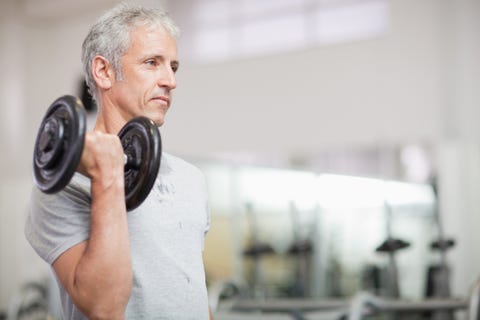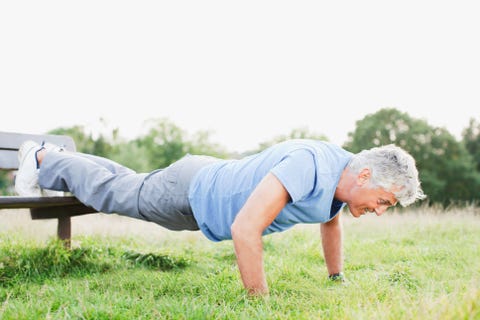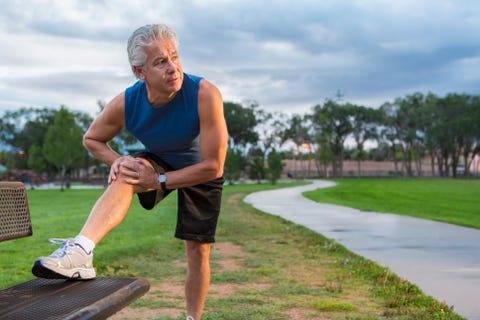
If you’re over 40, you probably have more “stuff” going on in your life than you did at 21, making it difficult to focus on eating right and training regularly. And the enthusiasm you once had for exercise—especially if you haven’t seen the results you were hoping for—may have waned, too.
You might feel that your body can’t handle the kind of punishment you used to dish out in your early twenties, and that it takes longer to recover than it used to. But none of this matters. With the right type of training, you can still build muscle and get strong well into your forties, fifties, and beyond.
You can start by trying out a new routine, like the Men’s Heath MA40 program. The 8-week regimen from trainer David Jack is specifically designed for guys who have logged plenty of miles over the years — but still have plenty of gas left in the tank.
You might be hesitant to jump into a new routine at this point in your life, but you might be surprised at what you can do.
Older Guys Can Still Make Gains
University of Oklahoma researchers compared people of different ages who followed the exact same program for eight weeks. They found that guys between 35 and 50 years old built just as much muscle as those between 18 and 22 years old. DEXA (duel-energy x-ray absorptiometry) scans showed that the college-aged men gained around two pounds of muscle, while the middle-aged men put on 2.5 pounds of muscle. Moreover, strength gains in both the bench press (7 pounds for the college-aged men and 14 pounds for the middle-aged men) and leg press (55 pounds for the college-aged men and 40 pounds for the middle-aged men) were similar in both groups.
The basic rules for building muscle as you age are mostly the same. Yes, the number of times you’ve travelled around the sun will affect the speed at which you make progress. But your age isn’t something you can change, so there’s no point worrying about it. You just need to train smart.
People of different ages respond to training in much the same way. It’s only the size of your results and the speed at which you attain them that varies.
So if you’re entering your forties, fifties, or even sixties and want to build muscle without injury, you can still make great gains by applying a few simple rules to your training program.
Embrace the Light
If you lift heavy all the time, you’ll start to notice little aches and pains in your knees, wrists, elbows, and shoulders. Eventually, those minor niggles will get so bad that they’ll interfere with your training. It will take weeks — maybe even months — before they clear up and you can train properly again.
Luckily, the solution is very simple: If going heavy on certain exercises causes you pain, just go light instead. Despite what some people might say, you can and will build muscle using lighter weights and higher reps.
In one study, high reps and light weights (3 sets of 30 to 40 reps) stimulated just as much muscle growth as heavy weights and lower reps (3 sets of 10 to 12 reps). Doing 3 sets of 10 repetitions to failure promotes similar gains in muscle size as 7 sets of 3 repetitions with a much heavier weight.
Japanese researchers found that taking a light weight and lifting it slowly increased both muscle size and strength to a similar extent as heavy training at a normal lifting speed. So mix it up. Heavy weights, medium weights, and light weights can all can be used successfully to gain muscle.
Keep Moving
The standard approach to dealing with an injury is to rest. But with some injuries at least, you may be better off moving.
Specifically, a form of resistance exercise known as eccentric training has been shown to work extremely well for the treatment of tendon pain in both the elbow and Achilles tendon. In some cases, it appears to potentially work better than surgery.
In one study, Swedish scientists studied the effect of heavy eccentric calf training in a group of 15 middle-aged recreational runners that had been diagnosed with Achilles tendinosis, which refers to a degeneration of the tendon’s collagen in response to chronic overuse. They had been in pain for an average of 18 months. Subjects were told to go ahead with the training even if they experienced pain, and to stop only if the pain became disabling.
At the start of the study, the pain was so bad that it kept them from running. But after 12 weeks of daily eccentric training (3 sets of 15 repetitions twice per day), all the runners were back at their pre-injury levels. A control group of 15 runners with the same diagnosis and duration of symptoms was treated conventionally. The conventional treatments were unsuccessful. All patients in the control group ended up having surgery.
In a group of subjects in their late forties with tennis elbow, the addition of an eccentric exercise known as the Tyler Twist to a standard physical therapy program led to a “marked improvement” in symptoms. They did 3 sets of 15 reps daily for approximately 6 weeks. The treatment was effective in the majority of patients. Similar results were seen in a group of men and women suffering from golfer’s elbow, even after all other treatments—physical therapy, cortisone injections, and pain killers—had previously failed.
There’s also some intriguing research to show that regular heavy strength training works just as well as eccentric training for the treatment of tendon pain. The study, carried in the Scandinavian Journal of Medicine and Science in Sports, compared three different treatments: corticosteroid injections, eccentric single-leg squats, and heavy slow (6 seconds per rep) resistance training.
Again, the researchers in this study emphasized the fact that pain during exercise was “acceptable” but shouldn’t get worse once the workout was over. At 12 weeks, all three treatments produced similar results. But it was a different story after six months. Specifically, the eccentric and resistance training group maintained their improvements whereas they deteriorated in the corticosteroid group.
If you’re injured, the first thing I’d suggest you do is get it checked out by a therapist rather than trying to sort it out yourself. And if what I’m telling you contradicts what they’re saying, take their advice and not mine.
Stimulate, Don’t Annihilate
There are plenty of people out there who train extremely hard yet make little or no progress despite all they’re effort. Walking out of the gym feeling like you’ve just gone several rounds with a heavyweight champ might leave you thinking that your workout has been an effective one. But if it’s not part of a structured plan that moves you towards a specific goal then much of that effort will be wasted.
If you keep on pushing your body to the limit in every workout, several things will happen. In the evening you will have that “wired but tired” feeling where you want to go to sleep but you can’t. You’ll find yourself staring at the ceiling wondering why you’re still awake at 2 a.m. You’ll wake up the next day with your heart pounding, just as tired as you were the night before.
Trivial things that you never even noticed before will start to annoy you. You’ll feel anxious, moody, irritable. Worst of all, your results in the gym will dry up and you will gradually start to get weaker. You need to train hard enough to stimulate progress, but not so hard that it has a negative impact on the quality of your other workouts.
Hard work is a tool used to stimulate a physiological improvement. It’s a means to an end, rather than the end itself.
Blast and Cruise
Your body isn’t a machine. It needs a rest now and again. Do this by including a “cruise” week (also known as a deload) for every 3 to 9 weeks of hard training.
Three weeks of intense training followed by a light week is a fairly widely accepted practice, although it’s not based on any research evidence that I’m aware of.
It’s not strictly necessary for everyone to deload after three weeks. But if I told you to deload “when you feel like it,” you probably wouldn’t do it at all. And your body wasn’t designed to go “all out” for 52 weeks of the year without some kind of break.
In general, the closer you are to your genetic potential (i.e. the upper limit of what you’re capable of in terms of size and strength), the more often you’ll need to deload. Those who are farther away from their genetic potential will be able to reload less frequently.
Stretch What’s Tight
Static stretching has been heavily criticized in recent years. That’s because it doesn’t do a lot of the things it’s supposed to. Most of the research out there shows that stretching has little effect on muscle soreness, and doesn’t appear to do much for injury prevention either.
However, if you find that certain muscles feel a little “tight” (the hamstrings, hip flexors, quadriceps, and gluteals are the usual culprits), or there’s an “asymmetry” in flexibility (i.e. one leg feels substantially tighter than the other) then it’s worth experimenting with some static stretching to see if it makes you feel any better.
If you want a simple prescription for flexibility, aim to stretch any “tight” muscles for a total of 60 seconds per day.
Stretching for 60 seconds has been shown to improve flexibility more quickly than a 30-second or 15-second stretch in a group of subjects aged between 65 and 97, all with “tight” hamstring muscles. What’s more, participants who stretched for 60 seconds remained more flexible for longer than subjects in the other groups.
One stretch lasting 60 seconds or six stretches lasting 10 seconds work equally well when it comes to increasing flexibility. Regardless of the length of a single stretch, the key to improvement seems to be total daily stretch time. Don’t get discouraged if your flexibility hits a ceiling, though. Like most things, flexibility is influenced by your genes.
A gene called COL5A1 is linked to your hereditary level of flexibility. One version of the gene means you’re quite flexible, the other means you’re not. Which means that the rate at which your flexibility improves, as well as the point at which it stops improving, are not entirely under your control.
Three Is Enough
There is no correct training frequency that works for all people, all of the time. Nor are there rigid guidelines that determine exactly what your training routine should look like at any stage of life.
You may be doing just fine on a program that involves lifting weights 4 to 5 times a week. If that’s the case, keep doing it.
However, from the studies I’ve read and my experience with clients, a program that involves lifting weights no more than three times a week is best for anyone in their forties. It allows for more recovery time, and keeps big, demanding exercises like the squat and the deadlift away from each other in your programming.
Take Your Time
Many in their late teens and early twenties will walk straight into the gym, do a few arm circles, and then jump straight into the heavy stuff. If you’re over 40, this approach will get you injured sooner or later. You have to make the time to warm up properly.
The exact warmup that you do will depend on what your workout looks like. It will also vary from person to person, depending on the environment you’re training in, how strong you are, and so on. So let me walk you through how I do it.
I like to start each workout with around 10 minutes of low-intensity cycling on an exercise bike. A rowing machine will also do the job just fine. This helps to raise your body temperature, which appears to be one of the main reasons that exercise performance is better in the evening than it is in the morning.
The amount of time you spend doing this will depend on the environment you’re training in. If it’s very warm, you might be able to get away with a few minutes on the bike or rowing machine. If it’s cold, you’ll need to spend a little longer warming up.
While I’m on the bike, I’ll open my training diary and write down what I’m about to do. This helps to clear my mind and gets me focused on the workout to come. Having a plan written down means that I don’t need to think about anything. All I need to do is follow the plan and focus on training as hard as I can.
Next, I move straight to my first exercise — usually one of the compound lifts, such as the bench press or squat — and perform 15 reps with an empty bar. Then, I progressively increase the weight over the course of several sets. All of this helps to prepare the joints, the muscles, and the nervous system that controls those muscles for the heavy work to come.
While a good warmup can reduce the risk of injury and improve your performance, it doesn’t need to last forever. Foam rolling, dynamic activation drills, and various “alignment” exercises can be useful at certain times and for certain individuals.
Don’t just copy what other people are doing—choose things that are actually helping your own body and workout.
Pick Your Battles
Some people have a bone structure that makes them better suited to certain exercises than others. You might not be built for deep squats with a heavy barbell across your shoulders, deadlifts from the floor, chinups from a straight bar, or bench pressing through a full range of motion.
If you’ve got short arms and long legs, for example, it’ll be a lot harder to deadlift from the floor without rounding your back compared to someone with long arms and short legs. But that doesn’t mean you should give up on the deadlift. Just do rack pulls instead, using a starting position that allows you to maintain normal spinal curvature.
If your wrists hurt when you’re doing chinups from a straight bar, use a suspension trainer. This allows your wrists to move freely rather than being locked in the same position throughout the movement.
If the bench press hurts your shoulders, try the floor press, where you stop the bar 2 to 3 inches off your chest. Or use dumbbells with your palms turned in and elbows moved closer to your body (this one simple tweak is often enough to get rid of shoulder pain almost instantly).
And don’t worry if you can’t squat “ass-to-ankles” without losing the arch in your lower back. Squatting to parallel, or even slightly above parallel, is good enough. Studies have found that you don’t need to train through a full range of motion to make your muscles grow, especially if doing so causes you pain.
Finding alternative moves that are easier on your joints is one of the main focuses of the MA40 program. Try it out, along with all the advice and guidance here, and you’ll be on the road to getting into the best shape of your life.

You can check out the latest Entertainment News by clicking: Click Here
Click the logo below to go to the Home Page of the Website










